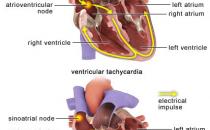Pericarditis

Produced by Louise Abbott, Bupa Health Information Team, February 2012.
This factsheet is for people who have pericarditis, or who would like information about it.
Pericarditis is inflammation of the pericardium (the sac that surrounds and protects your heart).
About pericarditis
Symptoms of pericarditis
Complications of pericarditis
Causes of pericarditis
Diagnosis of pericarditis
Treatment of pericarditis
About pericarditis
Your heart is surrounded by a double-layered sac called the pericardium. If your pericardium becomes inflamed, you have pericarditis. The causes of pericarditis are often unknown, but there are many reasons why it can happen.
Pericarditis can reoccur, which means it can get better and then return again after many years.
Symptoms of pericarditis
The main symptom of pericarditis is a sharp, constant pain in your chest. You may find this gets better when you're sat leaning forwards. The pain may spread to your left shoulder and arm. It usually gets worse if you lie on your left side, when you breathe in, swallow or cough. Other symptoms include:
• a fever
• a cough
• breathlessness
• joint pain
These symptoms aren't always caused by pericarditis but if you have them, see a doctor.
Complications of pericarditis
Pericarditis can lead to two complications called pericardial effusion and constrictive pericarditis. You will need further treatment if you develop either of these complications.
Pericardial effusion
Pericardial effusion is fluid building up between the two layers of your pericardium. If too much fluid builds up here it can prevent your heart from filling properly because of the increased pressure. This is known as cardiac tamponade.
If you have pericardial effusion, you may need to have a procedure carried out to drain the excess fluid and allow your heart to work well again. This is called pericardiocentesis or a pericardial tap.
Constrictive pericarditis
Constrictive pericarditis is a thickening and hardening of your pericardium. This is usually as a result of a long-term infection of your pericardium, often because of tuberculosis. However, there may be no clear cause. The thickened pericardium stops your heart from filling properly between heartbeats. You may need to have an operation to remove part or all of your pericardium so that your heart can return to normal functioning.
Causes of pericarditis
Pericarditis happens when fluid, blood or damaged tissue builds up in the space between the two layers of your pericardium. In many people, it's not known what causes their pericarditis. However, there are some things that are known to cause pericarditis, which include:
• infections that may be caused by viruses or bacteria, particularly tuberculosis bacteria
• inflammatory conditions, such as rheumatoid arthritis, systemic lupus erythematosus and rheumatic fever
• problems with your metabolism, such as kidney failure and underactive thyroid (hypothyroidism)
• a heart attack
• certain types of cancer, especially breast cancer
• reactions to medicines
• radiotherapy on your chest
• heart surgery, such as having a pacemaker fitted
• an injury to your chest
Diagnosis of pericarditis
Your doctor will ask about your symptoms and examine you. He or she will listen to your heart with a stethoscope. Your doctor may be able to hear a 'rubbing' sound called pericardial rub, which is a sign of pericarditis. He or she will ask you if you have recently had symptoms of a viral infection, such as a cold or flu and any other symptoms that might suggest an underlying illness.
Your doctor may refer you to a cardiologist (a doctor who specialises in conditions of the heart and blood vessels) for further tests.
You may need to have an echocardiogram (an ultrasound scan of your heart) so that your doctor can see if there is any fluid in between the two layers of your pericardium.
Other tests you may have include the following.
• Blood tests. These can be used to check for signs of inflammation.
• An electrocardiogram (ECG). This test measures the electrical activity of your heart to see how well it's working. There are certain changes that your doctor can look for that might help in diagnosing pericarditis.
• A chest X-ray. If there is a large amount of fluid within your pericardium, the X-ray may show that your heart is enlarged.
• A CT scan. If your pericardium is thickened because of constrictive pericarditis, this will show up in this scan.
• An MRI scan. This is useful to see if there is also inflammation of the heart muscle (called myopericarditis).
• An angiogram. This test uses an injection of a special dye into your blood vessels to make them clearly visible on X-ray images. This will show if there are problems other than pericarditis, such as a problem in your coronary arteries (the arteries that supply your heart muscle with blood).
• Examination of pericardial fluid. If it's possible for your doctor to drain fluid from your pericardium, these samples will be tested for signs of infection and examined for possible cancer cells.
It's possible that pericarditis is diagnosed more often than it should be. Some people can have an ECG result that might suggest they have pericarditis, but that result is normal for them. If you go to see a doctor because of chest pain, it's possible that you may be diagnosed with pericarditis. However, if you don't have a fever and your blood tests and echocardiogram don't show signs of pericarditis, your pain may be muscular. You may need to have further MRI or CT scans to confirm the underlying cause of your pain.
Please note that availability and use of specific tests may vary from country to country.
Treatment of pericarditis
You will be treated for any underlying cause of pericarditis, if possible. For example, if it's caused by an infection such as tuberculosis, your doctor will prescribe a course of antibiotics for you to take.
Your doctor will usually prescribe you non-steroidal anti-inflammatory drugs (NSAIDs) for the pain. Some types of pericarditis can be treated with certain corticosteroid medicines. If you have reoccurring pericarditis, your doctor may prescribe you a medicine called colchicine.
Always read the information leaflet that comes with your medicine, and if you have any questions ask your pharmacist or doctor for advice.
If the inflammation of your pericardium also involves the outer layer of heart muscle underlying your pericardium, a condition called myopericarditis, your doctor will advise you not to do any strenuous activity for a few weeks. Doing exercise when you have myopericarditis can cause a problem with your heart rhythm, which can be fatal.
Availability and use of different treatments may vary from country to country. Ask your doctor for advice on your treatment options.
Answers to questions about pericarditis
This section contains answers to common questions about this topic. Questions have been suggested by health professionals, website feedback and requests via email.
What does an echocardiogram involve?
How long after a heart attack does it usually take for pericarditis to develop?
What is the difference between pericarditis and myocarditis?
What does an echocardiogram involve?
An echocardiogram is an ultrasound scan of your heart. You may need to have an echocardiogram if your doctor thinks you have pericarditis.
Explanation
An ultrasound scan uses sound waves to produce an image of the inside of your body. An echocardiogram is an ultrasound scan that is used to specifically look at the structure and function of your heart.
If you’re having an echocardiogram, your doctor will apply a clear gel to the skin on the left side of your chest, over your heart.
You will be asked to lie on a couch. An ultrasound probe is held firmly against your skin and moved over the surface. The probe will start to give out ultrasound waves (you won't be able to feel these).
The echocardiogram machine detects the ultrasound waves that have bounced back, creating a moving image of your heart on a screen.
How long after a heart attack does it usually take for pericarditis to develop?
Pericarditis can occur as little as two days after a heart attack. However, it usually takes longer than this to develop.
Explanation
Pericarditis happens when there is blood, fluid or damaged tissue in between the two layers of your pericardium. This can be caused by a heart attack.
Pericarditis that occurs after a heart attack is known as Dressler’s syndrome. Pericarditis can occur two days after a heart attack. However, it usually takes longer to develop, commonly happening between two and 10 weeks after a heart attack.
What is the difference between pericarditis and myocarditis?
Both pericarditis and myocarditis refer to inflammation in and around your heart. Pericarditis is inflammation of your pericardium – the sac that surrounds your heart. Myocarditis is inflammation of your heart muscle itself. Often, pericarditis and myocarditis occur together.
Explanation
Myocarditis is inflammation of your myocardium - the muscle in your heart wall that contracts to pump blood around your body. Infection with a virus is the most common cause of myocarditis. It can also be caused by sensitivity to certain drugs, but often the cause isn’t known.
Symptoms of myocarditis include feeling breathless, tired and having chest pain and/or palpitations (an unpleasant awareness of your heartbeat, often described as a thumping in your chest). Myocarditis is usually mild and doesn’t need any treatment, but if it’s causing problems with the function of your heart, your doctor can prescribe you some medicines to take.
Pericarditis is inflammation of your pericardium – the sac that surrounds your heart. It has many different causes. The main symptom of pericarditis is a constant sharp pain in your chest. It’s usually treated with non-steroidal anti-inflammatory drugs (NSAIDs).
Keywords: pericarditis, heart, inflammation, myocarditis, echocardiogram, ultrasound, heart attack, Dressler’s syndrome
Further information
• British Heart Foundation
0300 330 3311
www.bhf.org.uk
Sources
- Khandaker M, Espinosa R, Nishimura R, et al. Pericardial disease: diagnosis and management. Mayo Clin Proc 2010; 85(6):572–93. doi:10.4065/mcp.2010.0046
- Rahman A, Liu D. Pericarditis – clinical features and management. Aust Fam Physician 2011; 40(10):791–6. www.racgp.org.au
- Chest pain – management. Prodigy. www.prodigy.clarity.co.uk, published December 2010
- Acute pericarditis. eMedicine. www.emedicine.medscape.com, published 10 October 2011
- Maisch B, Seferović P, Ristić A, et al. Guidelines on the diagnosis and management of pericardial diseases. Eur Heart J 2004; 25(7):587–610. doi:10.1016/j.ehj.2004.02.002
- Pericardiocentesis. eMedicine. www.emedicine.medscape.com, published 4 August 2011
- Pericarditis. The Merck Manuals. www.merckmanuals.com, published September 2006
- Pericardial disease. Map of Medicine. www.mapofmedicine.com, published 19 April 2011
- Personal communication, Dr Tim Cripps DM FRCP, Consultant Cardiologist, Bristol Heart Institute, 11 January 2012
- Patient information leaflet: transthoracic echocardiography. British Society of Echocardiography. www.bsecho.org, accessed 28 December 2011
- What to expect during echocardiography. National Heart Lung and Blood Institute. www.nhlbi.nih.gov, published 31 October 2011
- Acute coronary syndromes (ACS). The Merck Manuals. www.merckmanuals.com, published December 2007
- Myocarditis in emergency medicine. eMedicine. www.emedicine.medscape.com, published 8 December 2010
- Oakley C. Myocarditis, pericarditis and other pericardial diseases. Heart 2000; 84(4):449–54. doi:10.1136/heart.84.4.449
This information was published by Bupa’s Health Information Team and is based on reputable sources of medical evidence. It has been peer reviewed by Bupa doctors. The content is intended for general information only and does not replace the need for personal advice from a qualified health professional.
Related topics
• Angiogram (cardiac catheterisation)
• Antibiotics
• CT scan
• Diagnosing heart conditions
• Echocardiogram
• Electrocardiogram (ECG)
• Heart attack
• MRI scan
• Non-steroidal anti-inflammatory drugs (NSAIDs)
• Radiotherapy
• Rheumatoid arthritis
• Systemic lupus erythematosus (SLE)
• Tuberculosis
• Underactive thyroid (hypothyroidism)
• X-ray















